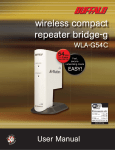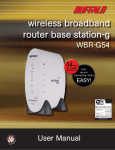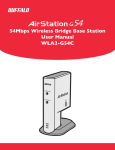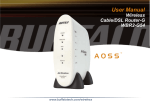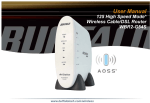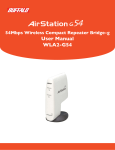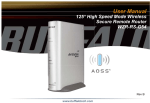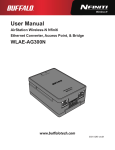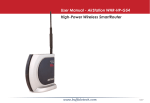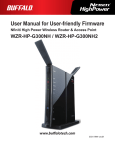Download Buffalo AIRSTATION WBR-G54 System information
Transcript
WBR- G54 AirStation™ Broadband Router Manual CONTENTS INTRODUCTION . . . . . . . . . . . . . . . . . . . . . . . . . . . . . . . . . . . . . . . . . . 1 1.1 AirStation Broadband Router Access Point (WBR-G54) . . . . . . . . . . . . 1 1.2 AirStation Wireless Network Features . . . . . . . . . . . . . . . . . . . . . . . 1 1.3 Home Networking . . . . . . . . . . . . . . . . . . . . . . . . . . . . . . . . . . . . . 2 1.4 SOHO/SMB Networking. . . . . . . . . . . . . . . . . . . . . . . . . . . . . . . . . . 2 1.5 Buffalo Anywhere Networking . . . . . . . . . . . . . . . . . . . . . . . . . . . . . 2 1.6 AirStation BroadBand Router Access Point Package . . . . . . . . . . . . . . 3 1.7 Product Views . . . . . . . . . . . . . . . . . . . . . . . . . . . . . . . . . . . . . . . 3 1.8 About the AirStation CD . . . . . . . . . . . . . . . . . . . . . . . . . . . . . . . . 3 BASIC SETUP . . . . . . . . . . . . . . . . . . . . . . . . . . . . . . . . . . . . . . . . . . . 3 2.1 Using AirNavigator . . . . . . . . . . . . . . . . . . . . . . . . . . . . . . . . . . . . 3 STANDARD SETTINGS . . . . . . . . . . . . . . . . . . . . . . . . . . . . . . . . . . . . . 6 3.1 Introduction . . . . . . . . . . . . . . . . . . . . . . . . . . . . . . . . . . . . . . . . . 6 3.2 Setup Preparation . . . . . . . . . . . . . . . . . . . . . . . . . . . . . . . . . . . . 6 3.3 Setup Overview . . . . . . . . . . . . . . . . . . . . . . . . . . . . . . . . . . . . . . 6 3.4 Open the Setup Screen . . . . . . . . . . . . . . . . . . . . . . . . . . . . . . . . 6 3.5 Input Parameters Through the Client Manager . . . . . . . . . . . . . . . . . 6 3.5.1 DSL Button. . . . . . . . . . . . . . . . . . . . . . . . . . . . . . . . . . . . . . . . . 7 3.5.2 CATV Button . . . . . . . . . . . . . . . . . . . . . . . . . . . . . . . . . . . . . . . 7 3.5.3 Line Test Tab . . . . . . . . . . . . . . . . . . . . . . . . . . . . . . . . . . . . . . . 7 3.5.4 Security Tab . . . . . . . . . . . . . . . . . . . . . . . . . . . . . . . . . . . . . . . . 8 3.5.5 Application Tab. . . . . . . . . . . . . . . . . . . . . . . . . . . . . . . . . . . . . . 8 USING AIRSTATION FOR ADVANCED CONFIGURATIONS 4.1 LAN Setting. . . . . . . . . . . . . . . . . . . . . . . . . . . . 4.1.1 Wireless . . . . . . . . . . . . . . . . . . . . . . . . . . . . . 4.1.2 LAN Port . . . . . . . . . . . . . . . . . . . . . . . . . . . . 4.1.3 DHCP Server . . . . . . . . . . . . . . . . . . . . . . . . . . 4.1.4 Wireless LAN Computer Limitation . . . . . . . . . . 4.1.5 WDS . . . . . . . . . . . . . . . . . . . . . . . . . . . . . . . 4.2.1 WAN Port . . . . . . . . . . . . . . . . . . . . . . . . . . . 4.2.2 Network WAN . . . . . . . . . . . . . . . . . . . . . . . . . 4.3 Network Setting . . . . . . . . . . . . . . . . . . . . . . . 4.3.1 Routing Setup . . . . . . . . . . . . . . . . . . . . . . . . 4.3.2 Address Translation . . . . . . . . . . . . . . . . . . . 4.3.3 Packet Filter . . . . . . . . . . . . . . . . . . . . . . . . . 4.3.4 Intrusion Detector. . . . . . . . . . . . . . . . . . . . . . 4.3.5 UPnP . . . . . . . . . . . . . . . . . . . . . . . . . . . . . . 4.4 Management (Network Diagnosis Settings) . . . . . ..............8 ..............8 ..............8 ..............9 . . . . . . . . . . . . . 10 . . . . . . . . . . . . . 11 . . . . . . . . . . . . . 11 . . . . . . . . . . . . . 12 . . . . . . . . . . . . . 13 . . . . . . . . . . . . . 13 . . . . . . . . . . . . . 13 . . . . . . . . . . . . . 14 . . . . . . . . . . . . . 15 . . . . . . . . . . . . . 16 . . . . . . . . . . . . . 16 . . . . . . . . . . . . . 16 i 4.4.1 Unit information . . . . . . . 4.4.2 Time setup. . . . . . . . . . . 4.4.3 System Information . . . . 4.4.4 Transfer Packet Condition 4.4.5 Log Information . . . . . . . 4.4.7 PING Test . . . . . . . . . . . 4.4.8 Initialization/Reboot . . . . 4.4.9 Firmware Update . . . . . . . . . . . . . . . . . . . . . . . . . . . . . . . . . . . . . . . . . . . . . . . . . . . . . . . . . . . . . . . . . . . . . . . . . . . . . . . . . . . . . . . . . . . . . . . . . . . . . . . . . . . . . . . . . . . . . . . . . . . . . . . . . . . . . . . . . . . . . . . . . . . . . . . . . . . . . . . . . . . . . . . . . . . . . . . . . . . . . . . . . . . . . . . . . . . . . . . . . . . . . . . . . . . . . . . . . . . . . . . . . . . . . . . . . . . . . . 16 17 17 18 18 18 19 19 ADDITIONAL INFORMATION . . . . . . . . . . . . . . . . . . . . . . . . . . . . . . . . 19 A. WBR-G54 ACCESS POINT SPECIFICATIONS . . . . . . . . . . . . . . . . . . . . Physical Specifications . . . . . . . . . . . . . . . . . . . . . . . . . . . . . . . . . . . Temperature & Humidity . . . . . . . . . . . . . . . . . . . . . . . . . . . . . . . . . . Power Characteristics . . . . . . . . . . . . . . . . . . . . . . . . . . . . . . . . . . . . Regulatory Information . . . . . . . . . . . . . . . . . . . . . . . . . . . . . . . . . . . Networking Characteristics . . . . . . . . . . . . . . . . . . . . . . . . . . . . . . . . . Radio Characteristics . . . . . . . . . . . . . . . . . . . . . . . . . . . . . . . . . . . . . Transmit Rate . . . . . . . . . . . . . . . . . . . . . . . . . . . . . . . . . . . . . . . . . Automatic Transit Rate Select (when not in Turbo mode) . . . . . . . . . . . 21 21 21 21 21 21 21 21 21 B. 1 Common Troubleshooting Tips. . . . . . . . . . . . . . . . . . . . . . . . . . . 22 B.1.1 LED Activity B . . . . . . . . . . . . . . . . . . . . . . . . . . . . . . . . . . . . . . 22 B. 1.2 LEDs Work But Client PC Cannot Connect to Network. . . . . . . . . . 22 B. 1.3 Other Problems . . . . . . . . . . . . . . . . . . . . . . . . . . . . . . . . . . . . 22 Glossary . . . . . . . . . . . . . . . . . . . . . . . . . . . . . . . . . . . . . . . . . . . . . 23 ii INTRODUCTION 1.1 AirStation Broadband Router Access Point (WBR-G54)1 Welcome to AirStation, the easy way to ultra fast wireless networking. Bring your wireless home network closer to your entertainment! This book, which describes the most common configurations, introduces you to the High Speed AirStation Broadband router access point, and will help you connect to your network quickly. The High Speed AirStation Broadband Router Access Point (AP), WBR-G54, is a 4-port router wireless small/medium business (SMB) network device that complies with the IEEE 802.11b (Revision B) standard and the IEEE 802.11g draft specification on wireless LANs with turbo data rate. IEEE 802.11g technology features longer range than IEEE 802.11a and greater bandwidth with data rates up to 54 Mbps in the turbo mode. WBR-G54 supports enhanced built-in firewall functions and it is used as a multi-functional router/link between wired and wireless LAN PCs. The WBR-G54 incorporates features of wired and wireless networking environments. Summary of the AirStation WBR-G54 features: • Wi-Fi™ (Wireless Fidelity) certified by the Wi-Fi Alliance. AirStation will communicate with other IEEE 802.11b/Wi-Fi compliant wireless LAN products. • Automatic Transmit Rate Select mechanism transmits at speeds of 24, 12, 11, 5.5, 2 and 1 Mbps. • Supports turbo mode of 36, 48 and up to 54 Mbps. • Ability to set a fixed data rate for faster than 11 Mbps ignoring 802.11b legacy devices. • DHCP client/server function. • Auto roaming, supports seamless roaming over multiple channels. • Auto VPN setup, for secure communications. • Additional Firewall Functions - DMZ, intrusion detection and notification • Up to 128bit Wired Equivalent Privacy (WEP) data encryption (future support for WPA and TKIP). • Packet Filtering for eliminating unwanted communications. • SOHO/SMB routing and firewall functions provide a safer private networking environment, including MS NetMeeting and MSN-Messenger. • Syslog transmits some or all system activities to a central Syslog server. • Extended range, with optional add-on antennas. • Auto Media Dependent Interface/ Crossover (MDI/X) port, allows connection by standard and crossover CAT5 cables. • Supports Universal Plug and Play (UPnP). Other features to be supported by upgrades: • EAP-TLS, expanding the 802.1x authentication method. • PPPoE multi-session, for use with multiple stations. 1.2 AirStation Wireless Network Features 1 • Enhanced security features: - Firewall and DMZ zone functions to prevent unknown intruders. - Intrusion detection with a pop-up warning for DoS, malicious attacks and rejection. - Dynamic packet filtering function prevents specified ports being open to WAN during periods of nonuse. - Up to 128bit WEP for protecting data. - VPN (IPSec and PPTP) pass-through - Packet monitoring and filtering by MAC address, IP address and port. - PPPoE support - Internal Network Security, for blocking changes to AP configuration by wireless clients or through another AP. 1 • Buffalo’s easy connection method and picture guided setup instruction. • Broadband router static and dynamic routing methods between WAN and LAN based on updated routing tables. An economical way to bridge multiple networks. • Optional external antennas for boosting range and signal quality. • Resistance to environmental conditions. 1.3 Home Networking 1 For the future home entertainment applications that carry hard drives for storing hundreds of titles, IEEE 802.11g can transmit three channels of CD-quality voice, or DVD-quality video to every room in the home simultaneously. Buffalo’s AirStation wireless access point enables sharing broadband at your fingertips. All you need to do is connect the AirStation to a DSL or CATV modem to: • Share files and printers • Access and share the Internet • Share home entertainment system Figure 1.4 SOHO/SMB Networking 1.4 SOHO/SMB Networking With high-speed DSL or CATV connections readily available, many users can work effectively from a home office, connected securely to a corporate network. Buffalo’s solutions are ideal for home networks that require secure, high-speed access to the corporate LAN. Tools that play an integral part in Buffalo’s solutions include VPN connectivity for secure access to corporate resources, which enable the remote employee to handle information from clients or coworkers as if they were in the office. IEEE 802.11g technology enables anticipated data intensive applications such as high security communication and VoIP. Connect the Buffalo AirStation Broadband router AP to a CATV or DSL modem in order to: • Share broadband access • Share files and printers • Bridge between multiple networks and multiple PC platforms • Provide easy and secure access to home or company networks from remote locations 1.5 Buffalo Anywhere Networking Mobile professionals can be productive while traveling by accessing standardsbased, secure, high-speed connections in many hotel, airports, convention centers, and even coffee shops. The WBR-G54 makes extending your LAN simple, secure, scalable, and manageable, in part through solutions like VPN, allowing mobile professionals to take their offices on the road effortlessly. When no wired broadband connections are available, wireless solutions in public spaces coupled with VPN can connect mobile workers to their businesses. Buffalo’s access point features make a home network system accessible from anywhere. Figure 1.5 Buffalo Anywhere Networking 2 Buffalo’s firewall function provides: • Protection of personal data/files by either eliminating the intruder on the spot or sending intruders to a nonfunctional zone • Notification of the attack (pop-up warning, email warning, and auto packet rejection) 1.6 AirStation Broadband Router Access Point Package The AirStation WBR-G54 package consists of the following items. 1. WBR-G54 Access Point 2. AC adapter 3. Power cable and connector 4. CAT5 straight cable 5. WBR-G54 Manual 6. WBR-G54 Utility CD 7. Warranty and Registration cards 1.7 Product Views 1.8 About the AirStation CD Prior to copying or installing the software, please read the Software License Agreement “license.txt”, located in the root folder of the CD. By installing, copying or using the AirStation software, you are consenting to the terms of this agreement. If you do not agree to all of the terms of the Software License Agreement, do not download, copy or install the AirStation software. It is the policy of Buffalo Technology to improve products as new technology, components, software and firmware become available. Before you proceed with the installation of this product, please consult the AirStation website (http://www.buffalotech.com) to download and install the latest software for your product. BASIC SETUP 2.1 Using AirNavigator For easy setup, the WBR-G54 CD contains a web-based utility, AirNavigator. Use it to set up the wireless LAN environment for both AP and PC (client). The Figure 2.1.1 AirStation Setup 3 Figure 2.1.2 AirStation Setup: Network Adapter system requires Explorer 4.0 or higher, or Netscape Communicator 4.0 or higher. To set up the parameters manually, refer to Chapter 3. Before installation, verify the PC is set up for browsing the Internet. 1. Insert the CD into the CD drive. The following screen will appear. For AirStation setup, select “Setup the AirStation” and click OK. 2. The Network Adapter confirmation screen will appear. Verify the adapter shown matches that of the PC. 3. Click Next until a list of access points shows up in the ESS-ID field. Buffalo’s ESS-ID is 12 digits and is found on the back of the AirStation, labeled LAN MAC Address. Select the one you want to communicate with and highlight it. Click Next. Figure 2.1.3 AirStation Selection 4. If the client IP range is different than the default AirStation IP of 192.168.11.1, an IP configuration screen will appear next. Select Automatically set up the IP address, or Specify an IP address for manual setup. Figure 2.1.4 Configure IP Address 4 Figure 2.1.5A Login Screen 5. A login screen will appear. • Enter “root” as the User name. • Leave the Password box blank (do not enter anything into the Password box) and click OK. Figure 2.1.5B AirStaton Initial Setup Screen If the following screen is shown, connection to the access point is complete. Figure 2.1.6 AirStation Setup: Complete 6. Click Finish. Figure 2.1.7 AirStation Setup: Shortcut 7. To place a shortcut icon on the desktop, click Yes. Otherwise, click No. 5 STANDARD SETTINGS 3.1 Introduction Setting up the AirStation parameters using Buffalo’s utility tool, Client Manager, requires basic wireless configuration knowledge. Setup includes manual wireless configuration and basic administrative management. For explanation of each parameter and its use, see Chapter 4. 3.2 Setup Preparation Make note of the WBR-G54’s wired MAC address (found on the back of the WBRG54). It is also recommended you record any other broadband access information such as global IP address, subnet mask address, default gateway address, DNS server address and PPPoE parameters. 3.3 Setup Overview The WBR-G54 CD contains the Client Manager program. The Client Manager is used for setting up and configuring the access point and for monitoring the wireless signal between the AP and client. 3.4 Open the Setup Screen • Connect the WBR-G54 according to the wiring instructions. (Install the setup utility, Client Manager, from the CD. • The WBR-G54 has a default LAN IP address of 192.168.11.1 and Subnet Mask of 255.255.255.0. Ex: The setting PC can use 192.168.11.2 as an IP and 255.255.255.0 as the Subnet Mask during setup unless a different IP range is entered for the AirStation. 1. Click Start and select Programs 4AirStation Utility4Client Manager 2. Select Edit4Search AirStation to find the nearest AirStation. 3. Highlight the WBR-G54, click the Admin menu button, then the Configure AirStation tab to open the setup screen. 4. The AirStation log-in screen will appear. 5. Enter “root” for User Name and leave Password blank Specialized setups for security, filtering and other features will be explained in later sections. Figure 3.5 Initial Settings Screen 3.5 Input Parameters Through the Client Manager • Click the appropriate button to select the type of broadband access. (Users more experienced in networking may choose to select the Advanced button and skip to Chapter 4.) • For supplementary tools, use the tabs along the top of the screen. 6 3.5.1 DSL Button Figure 3.5.1 DSL Button Select the appropriate connection method. Automatic IP Assignment by ISP - The DHCP server of the ISP assigns an IP address automatically. Enter IP address manually - Enter the IP address given by the ISP. PPPoE Connection - Enter the PPPoE information provided by the ISP. Figure 3.5.2 CATV Button 3.5.2 CATV Button Select the appropriate connection method. Automatic IP Assignment by ISP - The DHCP server of the ISP assigns an IP address automatically. Enter IP address manually - Enter the IP address given by the ISP. The IP address is acquired automatically but DNS server address entered manually - Enter the DNS server information manually even though the IP address is acquired automatically. Figure 3.5.3 Line Test Tab 3.5.3 Line Test Tab Tests the connection to the Internet. 7 3.5.4 Security tab Figure 3.5.4 Security Tab Set security parameters. Follow the instructions in each screen. 3.5.5 Application tab Figure 3.5.5 Application Tab Set up special applications such as games, MS NetMeeting and MSN Messenger. Follow the instructions in each screen. USING AIRSTATION FOR ADVANCED CONFIGURATIONS Although your AirStation will function fine using only the settings from Section 3, you may wish to explore more advanced options. This chapter explains each parameter in the Advanced button. Click the Top tab and click the Advanced button. Figure 4.1.1 LAN Setting 4.1 LAN Setting Set up LAN connections. 4.1.1 Wireless Wireless LAN operation setup. Wireless Mode - Select one of the following: 11g(54M)/11b(11M)-Auto - Allows communication of 11g and 11b devices. Communication speed will drop to 11Mbps when 11b devices are connected. 8 11g(54M)-Turbo - Boosts 11g devices to turbo 54Mbps mode. 11g(54M)-Only - 11g devices will be able to communicate, but not 11b devices. ESS-ID - Allows administrator to alter the ESS-ID of the AirStation. To communicate with a specific AP only, the AP’s ESS-ID must be entered in the client PC. The client PC looks for the specific AP (or ESS-ID) for wireless communication. Use up to 32 alphanumeric characters for the ESS-ID (case sensitive). ■Note: Roaming - When multiple AirStations have an identical ESS-ID, WEP, and DS channel, client PCs may Roam between the AirStations. Wireless Channel - Select the channel used for wireless communication. There are 11 overlapping channels. Channels 1, 6 and 11 are non-overlapping. If there are multiple APs in close proximity using the same channel, there may be interference. In this case, change to a non-overlapping channel. ■Note: This parameter is automatically set in the client computer. Encryption Key (WEP) - Select Encrypt or Do not encrypt. Create and enter an encryption code to protect wireless communications. It is possible to enter up to 4 different WEPs. The WEP key must match between two parties for secure communications. 0-9 and a-f, “20123456789abcdeabcdeabcde” BSS (Basic Service Set) Basic Rate Set - The transmission data rate between devices. If one device supports 2Mbps only, the data rate for the entire network should be limited to 2Mbps (“Default” selection). Otherwise, use 11Mbps max (“All” selection). DTIM Period - An access point transmits beacon signals to nearby clients at a preset interval. This parameter sets the beacon transmission interval time (1-255 sec.). Selection of a larger number may conserve energy for the client PC (when client power management is enabled), but may delay wireless communication. The default value of 1 is recommended. ANY Connection - Enables a client PC to connect to the nearest WBR-G54 by entering the word “any” for the ESS-ID. If the “ANY Connection” is not selected, the WBR-G54 will not be found unless the specific WBR-G54’s ESS-ID is entered in the client PC. 4.1.2 LAN port Set LAN interface parameters. LAN Side IP address - Allows administrator to specify a static IP and Subnet Mask for the LAN side of the AirStation. Figure 4.1.2 LAN Port Examples of WEP key: 64bit ASCII: 5 digits of alphanumeric characters, “ab34Y” 128bit ASCII: 13 digits of alphanumeric characters, “123456abcdef7” ■ Note: ASCII WEP is case sensitive. 64bit HEX: 10 digits, using characters 0-9 and a-f, “00234ABCDE” 128bit HEX: 26 digits, using characters 9 4.1.3 DHCP Server Figure 4.1.3A DHCP Server Allows a more advanced configuration of the DHCP server functions. DHCP Server Function - Allows administrator to enable/disable the DHCP server function for the AirStation LAN side. Select Use to enable or Do not use to disable this function. Assigned IP address (Range Assignment) - Sets the beginning address and range of addresses to be assigned by the AirStation’s DHCP server function. Select up to 253 consecutive addresses (nodes). The IPs to be excluded from the range specification should be entered in the specified field. Figure 4.1.3B DHCP Server Lease period - Specifies the number of hours (1-999) an assigned IP address is valid. The client PC will request a renewal of IP address at the end of the valid time period. Default Gateway - Allows administrator to use the Default Gateway address (the AirStation’s IP address), assign a specific Gateway address, or block clients from Gateway notification. ■Note: If the AP’s IP address is changed to a different range, the setting PC’s IP must be changed to the same range to continue configuration. Then restart the setup session from the AirStation utility screen. DHCP Server Function Simple Setting Allows administrator to enable/disable the DHCP server function for the AirStation LAN side. Select Use to enable and Do not use to disable the function. Once Use is selected, the assigned IP address range can be specified. Enter the starting LAN IP address and total number of PCs. 10 DNS server - Allows administrator to use the default DNS address (the AirStation’s IP address), assign specific DNS addresses, or block clients from DNS address notification. WINS server - Allows administrator to use a WINS address. Select auto assignment of the IP address, enter a specific WINS IP address, or block clients from the WINS address notification. Domain name - Allows administrator to use an assigned domain name, assign a specific domain name, or block clients from domain name notification. Domain names will be sent to LAN PCs when an IP address is assigned. Enter a maximum of 64 alphanumeric characters. Manual IP and MAC Address Assignment - Allows administrator to add additional leased IP addresses tied to a specific MAC address. When a specific MAC address connects to the AP, the IP address specified will be given to that client. Figure 4.1.4 Wireless LAN Computer Limitation Display/Delete lease information - List of IP addresses, MAC addresses, lease periods and status is displayed. 4.1.4 Wireless LAN Computer Limitation This option limits the PCs allowed a wireless connection to the AirStation. It is used to control the wireless connections to the access point. Wireless PC’s Connection - Select Limit to restrict the connection and Do not Limit for open access. Register your client PC’s MAC address before selecting Set. Figure 4.1.5 WDS Register for allowable PC’s MAC address - MAC access restriction set up in LAN. Input the MAC addresses that to be allowed to communicate. MAC address list - Display a table list of all MAC addresses. 4.1.5 WDS Wireless LAN PC connection: Select Enable or Disable wireless PCs from communication with the AirStation. If set to Disable, WDS (peer-to-peer AP connection) is still available. WDS Function: Select Enable to allow WDS mode between AirStations or Disable to block communication between AirStations. nNote: Both AirStations must be of the same type. Add AirStation (MAC Address): Allows administrator to register the wireless MAC address of AirStations for point-to-point or point-to multipoint communication between AirStations. The MAC address to enter is found in the Management section, under System Information/ Wireless MAC address section. The WDS function must be set to Enable. The MAC address is 12 characters long. Enter the Wireless MAC address in the form of two characters separated by a colon and click Add. Up to six sets may be registered. 11 4.2 WAN Settings Figure 4.2.1A WAN Port Settings 4.2.1 WAN Port Communication Method of Wired WAN - Select port speed and type of duplex connecting to the WAN port. If unknown, select Auto negotiation. MAC Address of WAN - Set the AirStation MAC address to be used for WAN communication. IP Address of WAN - Allows administrator to select DHCP server, PPPoE, or manual setting for the WAN port of the AirStation. Auto IP assignment from DHCP server - acquire the IP address automatically from the DHCP server. Figure 4.2.1B WAN Port Settings Use PPPoE client - If selected, the information listed below must be entered. Manual setting - Enter the appropriate IP address and subnet mask. PPPoE Setting (for enabling PPPoE Client function) - Allows administrator to use PPPoE as specified by the ISP. The following parameters should be entered: User Name - Enter the user name (up to 64 alphanumeric characters) for PPPoE authorization. Password - Enter password provided by ISP (up to 64 alphanumeric characters). Reenter password in the Confirmation box. Figure 4.2.2 Network Setup of WAN Service Name - Enter the PPPoE service name (up to 64 alphanumeric characters). If ISP doesn’t require service name, leave blank. Connection Type - Select from: • Continuous Connection - Connects immediately after setting and never disconnects. • Connect on Demand - Reconnects when the Disconnect time elapses. • Manual - Disables Automatic Connection. Connects to Internet using the Connect button on the initial settings page. 12 Figure 4.3.1A Routing Setup The Connect button will not appear until PPPoE is set. Disconnection Time - Specify the number of minutes (0-1440) before automatic disconnect is performed. If “0” is entered, disconnect function is disabled. If Continuous Connection is selected, the timer is disabled. Authorization - Authorization method for accessing the ISP PPPoE server. If unknown, select Auto authorization. MTU (Maximum Transmit Unit) Size Maximum Transmit Unit (578-1492) when using PPPoE. MRU (Maximum Receive Unit) Size - Maximum Receive Unit (578-1492) when using PPPoE. Port Number for WEB Setting - Set a specific port number when remote setup of the AirStation is planned. Keep Alive - Enables the PPPoE client to send a Link Control Protocol (LCP) echo request to the PPPoE server once per minute. If there is no reply within six minutes, the client disconnects. Set to Disable if frequent disconnection occurs. PING from WAN - Allows a PING test from WAN side. Select Do not respond or Respond. 4.3 Network Setting 4.3.1 Routing Setup WAN side (Internet) parameters. RIP transmission to WAN - Allows RIP transmission or None (no RIP) to WAN Host Name - Enter the host name as desired. RIP reception from WAN - Allows RIP reception or None (no RIP) from WAN 4.2.2 Network WAN Default Gateway - A default gateway IP should be assigned to the AirStation. If unknown, leave blank. If Auto IP assignment from DHCP Server was selected in section 4.1.3, a gateway IP is assigned automatically, provided the DHCP server is set to provide one. Figure 4.3.1B Routing Setup DNS Server Address - Enter the primary and secondary DNS address(es) of the server to be used by the WBR-G54 for DNS resolution. If DNS was set to Do not use (Section 4.1.3), leave blank. If Auto IP assignment from DHCP Server was selected, DNS addresses are assigned automatically, provided the DHCP server is set to provide them. 13 Figure 4.3.2A Address Translation RIP transmission to LAN - Allows RIP transmission or None (no RIP) to LAN RIP reception from LAN - Allows RIP reception or None (no RIP) from LAN Add Routing Table Entry • Destination address - Network IP address and subnet mask. • Gateway - Address through which the packet passes before it reaches the destination address. • Metric - Number of routers (1-15) to be passed before the packet reaches its destination. Display/Delete Routing Table (Entries) - Allows administrator to delete routing information. Figure 4.3.2B Address Translation 4.3.2 Address Translation Address Translation - Select Use or Do not Use. Address Translation must be enabled for client PCs to connect to the Internet. Selecting Use enables the following functions: • IP Masquerade - When the LAN PC connects to the WAN side, the IP address of LAN PC is dynamically translated to become the WAN IP address of the AirStation. Multiple LAN PCs can share one WAN IP address to access the Internet. • Static IP address translation -When the WAN requests connection to the LAN, the WAN IP address of the AirStation is translated into the IP address of the LAN PC. Figure 4.3.3A Packet Filter Log Output - Allows NAT log to be generated and issued. Select Discard Packet to disable. IP address of DMZ - Allows administrator to set the DMZ address. Incoming packets containing no recognizable destination port information will be redirected to the DMZ’s IP address. 14 IP address of WAN - Select AirStation’s IP address of WAN or Manual setting. For Manual setting, enter the IP address used by the WAN PC to connect to the local PC. Some network applications (online games or streaming software) require adding Address Translation tables). Figure 4.3.3B Packet Filter Protocol (WAN): • All - Selects all IP protocols. • ICMP - Network Diagnostic Protocol (1). • Manual - Specify the protocol number (0-255). • TCP/UDP - Enter port number. IP address of LAN - Select Manual and enter the destination IP address of the LAN PC; or select AirStation’s IP address of LAN. • Select Add to NAT table. Protocol (LAN) - Enter destination port number. If left blank, the packets are transferred to the same port number as the source port number. Display/Delete NAT Table - Allows administrator to delete NAT tables. 4.3.3 Packet Filter Log Output - Activates the packet filter log. Filter setting - Choose type from pulldown menu. For Manual setting: • Operation - Packets from WAN (or LAN), select ignored, rejected, or accepted. IP Address - Filter for the specific IP address • Destination IP Address - The IP address for the packet to arrive at. • Source IP Address - The IP address for the packet sender. Warning: If administrator selects Packet from LAN is Deny or Reject, the administrator will no longer have access to the AirStation configuration screens. This function prohibits setup from a wireless PC. The WBR-G54 can be returned to the factory default settings (ALL of them!) by holding down the INIT button on the back of the unit for three seconds. Protocol - Mark and select a specific protocol. Select from all protocols, ICMP, arbitrary protocol number and TCP/UDP protocol number. • All - Selects all IP protocols. • ICMP - Network Diagnostic Protocol (1). • Manual - Enter protocol number (0-255). • TCP/UDP Destination Port - Select TCP or UDP, then enter port number. Source MAC address - Enter the source MAC address to be filtered. ■Note: If configuring from a wireless PC, add your MAC address to the list of authorized wireless LAN PCs. The MAC address must be in two-digit groups separated by colons (Section 4.1.4). 15 Example: 00:40:26:00:11:22 Figure 4.3.4A Intrusion Detector Display/delete packet filter information - Allows the administrator to delete or initialize the packet filtering. 4.3.4 Intrusion Detector Intrusion Detector - Select Do not use, Use or Use (Apply Packet filter setting for Intrusion Detector setting). IP Spoofing - Check Block to prevent IP spoofing. Threshold Value - Enter the number (1-999) of packets before notification occurs. Notify by email • Notification email address - Enter destination email address • Sender email server address - Enter SMTP server address • Receiving email server authorization Enter POP3 Server address, User name and Password • Send test - Click Send to test notification Figure 4.3.4B Intrusion Detector Pop-up notification - Client Manager must be on to use this feature • Destination IP address - Enter address to be notified 4.3.5 UPnP Select Use to enable UPnP (Universal Plug and Play). When a computer with UPnP support connects to the AirStation, that computer automatically receives configuration information from the AirStation. Figure 4.4.1 Unit Information 4.4 Management (Network Diagnosis Settings) 4.4.1 Unit information AirStation name - When using Client Manager and multiple AirStations, select a unique name to make it easier to identify each AirStation. 16 Administrator name - “root”, cannot be changed Figure 4.4.2 Time Setup Administrator password - Allows the administrator to enter an administrator password to restrict access to the setting screens. • New Password - Enter new password. Enter up to eight alphanumeric characters (case sensitive) • Confirm Password - Reenter the new password for confirmation 4.4.2 Time setup Time setup - Enter the current date and time, and click Set. Figure 4.4.3A System Information NTP - Select Use or Do not use. ■Note: If NTP is used, time is set automatically. NTP server name - Enter the NTP server name Check Interval - Enter the time interval for time check frequency Time Zone - Select local time zone Click Set. 4.4.3 System Information Displays System Settings and information. Figure 4.4.3B System Information 17 Figure 4.4.4 Transfer Packet Informatiion 4.4.4 Transfer Packet Condition Displays number of packets sent and received for wired WAN-LAN and wireless LAN traffic. 4.4.5 Log Information Display log info level - Select Error and/ or Notify to specify the types of reports to be logged by the AirStation. Display log info - Select the specific reports to be logged. Log information - Displays recorded logs. 4.4.6 Syslog transmitting Figure 4.4.5 Log Informatiion Select Use or Do not use • Syslog Server - Enter the IP address of the Syslog server. • Log Information Level - Select Error and/or Notify to specify the types of reports to be sent to the Syslog server. • Log Information - Select the specific reports to be sent to the Syslog server. Figure 4.4.7 Ping Test 4.4.7 PING Test Destination - Enter IP address for test and click OK 18 4.4.8 Initialization/Reboot Figure 4.4.8 Initialization Reboot Initialization sets all parameters back to factory defaults. After initialization, the AirStation must be restarted. Figure 4.4.9 Firmware Uupdate 4.4.9 Firmware Update Firmware file name - Enter the path and filename for new firmware or select Browse to search for the path Click Firmware Update to load firmware to the AirStation. ■Note: Firmware update does not erase current user settings. ADDITIONAL INFORMATION For more information, please consult one of the following: • The on-line help system of your AirStation wireless system - for information about software and driver functionality. • The AirStation website at: http://www.buffalotech.com - for frequently asked questions (FAQ’s) and Software Updates. 19 20 A. WBR-G54 ACCESS POINT SPECIFICATIONS Physical Specifications AA Dimensions (LxWxH) 205 x 170 x 76 mm Weight 620 grams Temperature & Humidity Operation 0° to 40° C Maximum humidity 80% Transit/Storage 0° to 40° C maximum humidity 80% (no condensation) Power Characteristics Transmit Mode 1.1A (Nominal), Power Supply 3.3 V Regulatory Information A Wireless communication is often subject to local radio regulations. Although AirStation wireless networking products have been designed for operation in the license-free 2.4 GHz band, local radio regulations may impose limitations on the use of wireless communication equipment. Networking Characteristics Compatibility _ IEEE 802.11 Standard for Wireless LANs (DSSS) • Wi-Fi (Wireless Fidelity) certified by the Wi-Fi Alliance for 802.11b communication Host Operating System Microsoft Windows® ME/98/NT4.0/2000/XP, Unix/Linux/MacOS Media Access Protocol CSMA/CA (Collision Avoidance) with Acknowledgment (ACK) Radio Characteristics A R-F Frequency Band 2.4 GHz (2400-2483 MHz) 11 selectable sub-channels Modulation Technique Direct Sequence Spread Spectrum • CCK for High & Medium Transmit Rate • DQPSK for Standard Transmit Rate • DBPSK for Low Transmit Rate Spreading 11-chip Barker Sequence Bit Error Rate (BER) Better than 10 -5 Nominal Output Power 15 dBm Transmit Rate Turbo Mode: Speed 54, 48, and 36 Mbps Automatic Transit Rate Select (when not in Turbo mode) Speed: 24, 12, 11, 6, 5.5, 2, and 1 Mbps Able to set for Rate ignoring 802.11b transmission. 21 B. 1 Common Troubleshooting Tips Common Problems: • Out of range, client cannot connect to the AirStation. • Configuration mismatch, client cannot connect to the AirStation. • Absence or conflict with the Client Driver. • Conflict of another device with the AirStation hardware. B.1.1 LED Activity B Monitoring LED activity helps identify problems. • Power LED should be GREEN, • Wireless LED should be GREEN if the line is active. If is it blinking GREEN, wireless communication is active. • Ethernet LED should be GREEN (100Mbps) or AMBER (10Mbps) while the communication is active. DIAG LED Activity Unplug the power for three seconds. Plug the power back in to monitor the DIAG LEDs during start-up. If the symptom matches Table B.1.1, email [email protected] or call 800688-7466 between the hours of 8:30 am and 7:30pm, CST. DIAG LED Display Time Description/Action Continuous Red Starting RAM Error Red flash, 2 times Starting Flash ROM Error Red flash, 3 times Starting A problem in the wired LAN side Red flash, 4 times Starting A problem in the wireless LAN side B. 1.2 LEDs Work But Client PC Cannot Connect to Network If the LEDs indicate that the network is working properly (Power LED is on, Transmit/ Receive LED blinks), check the TCP/IP settings of the network. Changing Client TCP/IP Settings in Windows Consult the LAN Administrator for TCP/IP settings. To add or change the TCP/IP Settings: 1. On the Windows task bar click Start. 2. Select Settings, then Control Panel. 3. Double-click on the Network icon to view the Network Properties. 4. From the list of installed components, verify the TCP/IP -> Buffalo WLI-USB-L11G wireless LAN adapter protocol (or appropriate wireless LAN adapter) is installed. • If this protocol is not yet installed, click the Add button and select the TCP/IP protocol from the list. Refer to Windows Help for more information. • If this protocol is installed, select this protocol and click the Properties button. Verify the parameters match the settings provided by your LAN Administrator. Make changes if necessary, and click OK. 5. When prompted, restart your computer. B. 1.3 Other Problems Please refer to www.buffalotech.com and www.airstation.com for further reference materials. 22 Glossary 10BaseT or 100BaseTx: 802.3 based Ethernet network that uses UTP (Unshielded twisted pair) cable and a star topology. 10 is 10 Mbps and 100 is 100 Mbps. 802.1x: The standard for wireless LAN authentication used between an AP and a client. 802.1x with EAP will initiate key handling. Ad-Hoc Network: The wireless network based on a peer-to-peer communications session. Also referred to as AdHoc. Bandwidth: The transmission capacity of a computer or a communication channel, stated in Megabits per second (Mbps). BSS (Basic Service Set): An 802.11 networking framework that includes an Access Point. Bus Mastering: A system in which the specified Input/Output device (e.g. NIC Card) can perform tasks without the intervention of the CPU. Client: A PC or workstation on a network. Cross-Over Wiring: A UTP cable that has its transmit and receive pair crossed to allow communications between two devices. DCE (Data Communications Equipment): Hardware used for communication with a Data Terminal Equipment (DTE) device. Default Gateway: The IP Address of either the nearest router or server for the LAN. Default Parameter: Parameter set by the manufacturer. Destination Address: The address portion of a packet that identifies the intended recipient station. DHCP (Dynamic Host Configuration Protocol): Based on BOOTP, it uses a pool of IP addresses, which it assigns to each device connected to it, and retrieves the address when the device becomes dormant for a period of time. DNS (Domain Name System): System used to map readable machine names into IP addresses Driver: Software that interfaces a computer with a specific hardware device. DSSS (Direct Sequence Spread Spectrum): Method of spreading a wireless signal into wide frequency bandwidth. DTE (Data Terminal Equipment): Device that controls data flowing to and from a computer. Dynamic IP Address: An IP address that is automatically assigned to a client station in a TCP/IP network, typically by a DHCP server. ESS (Extended Service Set): A set of two or more BSSs that form a single sub-network. ESS-ID is user identification used in the ESS LAN configuration. Ethernet: The most widely used architecture for Local Area Networks (LANs). It is a shared-media network architecture. The IEEE 802.3 standard details its functionality. Ethernet cable: A wire similar to telephone cable that carries signals between Ethernet devices. File and Print Sharing: A Microsoft application that allows computers on a network to share files and printers. Firmware: Programming inserted into programmable read-only memory, thus becoming a permanent part of a computing device. Frame: A fixed block of data, transmitted as a single entity. Also referred to as packet. Full-Duplex: To transmit on the same channel in both directions simultaneously. Gbps (Giga Bits per second): One billion bits per second. Half-duplex: To transmit on the same channel in both directions, one direction at a time. 23 Hub: A device which allows connection of computers and other devices to form a LAN. use one set of IP addresses for internal traffic and a second set for external traffic. IEEE (Institute of Electrical and Electronics Engineers): The professional organization which promotes development of electronics technology. NIC (Network Interface Card): An expansion card connected to a computer so the computer can be connected to a network. IP (Internet Protocol) Address: A unique 32-binary-digit number that identifies each sender or receiver of information sent in packets. Infrastructure: A wireless network or other small network in which the wireless network devices are made a part of the network through the Access Point. ISP (Internet Service Provider): A company that provides access to the Internet and other related services. IV (Initialization Vector): The header section of a message packet. LAN (Local Area Network): A group of computers and peripheral devices connected to share resources. Packet Filtering: Discarding unwanted network traffic based on its originating address or its type. PCI (Peripheral Component Interconnect): A bus that is connected directly to the CPU. PCMCIA (Personal Computer Memory Card International Association) Card: Removable module that adds features to a portable computer. Ping (Packet Internet Groper): An Internet utility used to determine whether a particular IP address is online. LED (Light Emitting Diode): The lights on a hardware device representing the activity through the ports. Plug and Play: Hardware that, once installed (“plugged in”), can immediately be used (“played”), as opposed to hardware that requires manual configuration. MAC (Medium Access Control) Address: A unique number that distinguishes network cards. PoE (Power over Ethernet): A mechanism to send DC power to a device using a CAT5 Ethernet cable. Mbps (Mega Bits Per Second): A measurement of millions of bits per second. PPPoE (Point-to-Point Protocol over Ethernet): A specification for connecting users on an Ethernet line to the Internet through a common broadband medium. MDI/X (Media Dependent Interface/Crossover): Port on a network hub or switch that crosses the incoming transmit lines with the outgoing receive lines. MHz (MegaHertz): One million cycles per second. MIB II: A database containing performance information and statistics on each device in a network. MIPS (Million Instructions Per Second): A measurement of processing speed. NAT (Network Address Translation): An internet standard that enables a LAN to 24 Packet: A block of data that is transferred as a single unit, also called a frame or a block. Protocol: A standard way of exchanging information between computers. RADIUS (Remote Authentication Dial In User Service): A server that issues authentication key to clients. RAM (Random Access Memory): Non-permanent memory. Repeater Hub: A device that collects, strengthens and transmits information to all connected devices, allowing the network to be extended to accommodate additional workstations. RC4: The encryption algorithm that is used in WEP. col), rather than TCP/IP for data transport and provides no security features. RJ-45 connector: An 8-pin connector used between a twisted pair cable and a data transmission device. TKIP (Temporal Key Integrity Protocol): An encryption method replacing WEP. TKIP uses random IV and frequent key exchanges. ROM (Read Only Memory): Permanent memory. Router: Device that can connect individual LANs and remote sites to a server. Roaming: The ability to use a wireless device while moving from one access point to another without losing the connection. Script: A macro or batch file containing instructions and used by a computer to perform a task. Server: Any computer that makes files or peripheral devices available to users of the network and has a resident Network OS. SMTP (Simple Mail Transfer Protocol): The protocol used to define and deliver electronic mail (e-mail) from one location to another. SNMP (Simple Network Management Protocol: An application layer protocol that outlines the formal structure for communication among network devices. Static IP Address: A permanent IP address is assigned to a node in a TCP/IP network. Also known as global IP. STP (Shielded Twisted Pair): Twisted Pair cable wrapped in a metal sheath to provide extra protection from external interfering signals. Subnet Mask: An eight-byte address divided into 4 parts separated by periods. TCP/IP (Transmission Control Protocol/ Internet Protocol): Protocol used by computers when communicating across the Internet or Intranet. TFTP (Trivial File Transfer Protocol): Simple form of FTP (File Transfer Protocol), which Uses UDP (User Datagram Proto- Topology: The shape of a LAN (Local Area Network) or other communications system. Twisted Pair: Cable that comprises 2 or more pair of insulated wires twisted together. UDP (User Datagram Protocol): A communication method (protocol) that offers a limited amount of service when messages are exchanged between computers in a network. UDP is used as an alternative to TCP/IP. Uplink: Link to the next level up in a communication hierarchy. UTP (Unshielded Twisted Pair) cable: Two or more unshielded wires twisted together to form a cable. WAN (Wide Area Network): A networking system covering a wide geographical area. WEP (Wired Equivalent Privacy): An encryption method based on 64 or 128bit algorithm. Web Browser: A software program that allows viewing of web pages. Wi-Fi (Wireless Fidelity): An organization that tests and assures interoperability among WLAN devices. Wire Speed: The maximum speed at which a given packet can be transferred using Ethernet and Fast Ethernet standard specifications. WLAN (Wireless LAN): A LAN topology using wireless devices. VPN (Virtual Private Network): A security method to connect remote LAN users to a corporate LAN system. 25




























